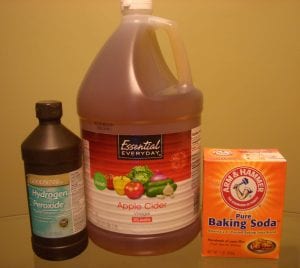Healthy Ways to Clean Your Home
 Our obsession with cleanliness has created a multi-billion dollar industry of a plethora of cleaning products for every surface. Rather than using good old-fashioned “elbow grease,” we have a vast array of chemical solvents to ease our cleaning burden, but in the process we have unwittingly created a toxic condition in our homes. We have been conned into believing that we need these harsh cleaners to clean and keep our homes safe, but in fact they are the leading cause of indoor air pollution.
Our obsession with cleanliness has created a multi-billion dollar industry of a plethora of cleaning products for every surface. Rather than using good old-fashioned “elbow grease,” we have a vast array of chemical solvents to ease our cleaning burden, but in the process we have unwittingly created a toxic condition in our homes. We have been conned into believing that we need these harsh cleaners to clean and keep our homes safe, but in fact they are the leading cause of indoor air pollution.
Most people think that if it’s on the grocery store shelf, it has been tested and proven to be safe. In fact, only about 30% of the roughly 17,000 chemicals used in common household products have been analyzed for their impact on human health. As you can imagine, the combination of chemicals makes this undertaking exponentially more complex. While most people know that mixing bleach and ammonia creates a toxic gas, how many other combinations create an unintended consequence?
Our senses were designed to detect danger. If it tastes bad, don’t eat it. If it smells bad, don’t breath it. So to mask the unpleasant odors of power cleaners, fragrances are added to make them more appealing to our sense of smell. We have been conditioned to believe that that “fresh” smell of air fresheners is good, but according to the National Academy of Sciences “95% of the ingredients used to create fragrances today are synthetic compounds derived from petroleum, including benzene derivatives, aldehydes and many other known toxins and sensitizers.” While manufacturers may be required to label hazards such as “poison” or “flammable” – they do not need to list anything more the primary ingredients.
Breathing in these chemicals on a regular basis has resulted in a significant increase in cases of asthma and allergic reactions, particularly in children. Not only that, but by chemically sanitizing everything, we may be robbing our children of the opportunity to develop a healthy immune system. It’s certainly a challenge to find the balance between living in harmony with healthy microbes and avoiding that which can make us dangerously ill. Our overuse of antibacterial soaps, for example, is likely to result in super bacteria.
While all of this may seem daunting and terribly complex, you can simplify things dramatically by retreating to three common cleaning materials:
- Hydrogen Peroxide is a miracle cleaner that has long been used as a natural disinfectant to clean wounds. However, it is great for cleaning countertops, floors and appliances, and requires no rinsing. It is a great stain remover and alternative to bleach.
- Vinegar is another versatile and age-old cleaner that is both economical and environmentally friendly. The acidic nature of vinegar makes it effective for killing most mold, germs and bacteria. It is extremely versatile and effective.
- Baking Soda has long been used to neutralize odors, but it also works very well as a scouring powder. Abundant, non-toxic and non-abrasive, this can be used as a paste (with vinegar or hydrogen peroxide) or with water.
There is a wealth of tips and more detailed information about each and combinations of these three compounds on the web, including sites that debunk false claims. For example, Earth911.com has nice article on how to clean your whole house with vinegar, baking soda and lemon. HouseLogic.com offers 10 clever uses for hydrogen peroxide. These are but two of dozens of good sources of information that can help you reclaim a healthier environment to live in at home.
Take a look under your sinks and see what you can do to simplify your cleaning supplies and habits. You’ll live a healthier life and save money as well!
This will be published in the Going Green section of the September 2013 issue of Spirit Seeker magazine.
